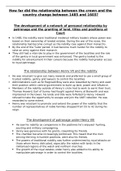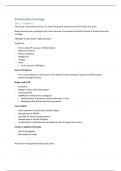summarized
Summary of A Short History of the Middle Ages by Barbara Rosenwein, 5 t h edition
Marleen Westeneng
An arrow () indicates a causality. The headings and sub-heading correspond to those in the
book.
Contents
1 ONE: Prelude: the Roman world transformed (c.300-c.600)...............................................................2
1.1 The Provincialization of the empire (c.250-c.350)........................................................................2
1.2 The Barbarians..............................................................................................................................2
EIGHT: Catastrophe and creativity (c.1350-1500)...................................................................................2
1.3 The new order..............................................................................................................................3
2 TWO: The Emergence of Sibling Cultures (c.600-c.750).......................................................................5
2.1 Saving Byzantium..........................................................................................................................5
2.2 The rise of the ‘Best community’: Islam........................................................................................6
2.3 The making of Western Europe....................................................................................................7
3 THREE: Creating new identities (c.750-c.900)....................................................................................10
3.1 Byzantium: From turning within to cautious expansion.............................................................10
3.2 The shift to the east in the Islamic world....................................................................................11
3.3 An Empire in spite of itself..........................................................................................................12
4 FOUR: Political Communities Reordered (c.900-c.1050)....................................................................14
4.1 Byzantium: The strengths and limits of centralization................................................................15
4.2 Division and development in the Islamic world..........................................................................16
4.3 The West: fragmentation and resilience.....................................................................................17
5 FIVE: New Configurations (c.1050-1150)...........................................................................................21
5.1 The Seljuks and the Almoravids..................................................................................................22
5.2 Byzantium: bloodied but unbowed.............................................................................................23
5.3 The quickening of the European economy.................................................................................23
5.4 Church reform and its aftermath................................................................................................24
5.5 Rulers with clout (power/influence)...........................................................................................26
5.6 New forms of learning an religious expression...........................................................................27
6 SIX: Institutionalizing aspirations (c.1150-1250)................................................................................29
6.1 The Islamic and Byzantine worlds in flux....................................................................................29
6.2 The institutionalization of government in the West...................................................................30
, 6.3 Culture and institutions in town and countryside.......................................................................33
6.4 European aggression within and without...................................................................................36
7 SEVEN: Tensions and reconciliations (c.1250-1350)..........................................................................37
7.1 The Islamic World Transformed..................................................................................................37
7.2 A global economy.......................................................................................................................39
7.3 Xenophobia.................................................................................................................................40
7.4 Strengthened monarchs and their adaptations..........................................................................41
7.5 The church militant, humiliated, and revamped.........................................................................44
7.6 The scholastic synthesis and its fraying......................................................................................44
7.7 Harmony and dissonance in writing, music and art....................................................................45
7.8 An age of scarcity?......................................................................................................................46
8 EIGHT: Catastrophe and creativity (c.1350-1500)..............................................................................47
8.1 Crisis and consolidations.............................................................................................................47
8.2 The church divided.....................................................................................................................51
8.3 Defining styles............................................................................................................................53
8.4 New horizons..............................................................................................................................54
1 ONE: Prelude: the Roman world transformed (c.300-c.600)
1.1 The Provincialization of the empire (c.250-c.350)
THE SOURCES OF GOD’S GRACE
- Priests and bishops had the powers of imposing penance on and forgiving sinners.
Based on Matt 16:18-19
- Eucharist (Mass): central liturgy. Very important and associated with imperial power.
- Saints:
In the early church martyrs
Greatly admired, holy
Healing people of illnesses and disputes
o Spiritual, physical and civic peace
When you had relics, you had the power of the saints
1.2 The Barbarians
- Barbarians:
Visigoths
o Sack of Rome 410
Franks
Burgundians
some were called Germans by Romans (Gemania: beyond the Rhine)
o Had been settled for a long time before entering the Empire
-Example of Germanic group: Wijster
150-400 AD
large wooden houses
cultivated grain and raised cattle (also horses)
2
EIGHT: Catastrophe and creativity (c.1350-1500)
, different crafts: carpenters, ironworkers, spinners, weavers
not egalitarian: wealthy few had access to Roman products
o trade (surplus)
kings leading military retinues had the power over the communities: labor service and
percentage of crop yields
- Ethnic differences:
differences in preferences that form identity
tribes came together and broke apart (ethnogenesis) (Goths)
- Around 250: Black Sea Goths plundered parts of the Balkans and Anatolia (Turkey)
many years of bitter fighting for Romans
Ostrogoths (East) and Visigoths (West) emerged
o Mid-330s: Visigoths allies of the Empire and in their armies
o Late 4th century: Roman army units made up of whole tribes (i.e. Goths or Franks)
(federates)
-376: Huns invaded Black Sea region
Nomadic people from steppeland of west-central Asia
Visigoths were driven from their settlements and were let into the Empire in huge
amounts famine, Romans mistreated Visigoths
o 378: Visigoths rebelled against Romans, killing emperor Valens at Adrianople
weakened the Roman army, possible end of Roman Empire
From 406: other barbarian groups entered the Empire (Gaul and Spain) with a ‘deal’ for
Rome:
o Alans, Vandals, Sueves, Ostrogoths, Rugi, Gepids
410: sack of Rome under Visigoth leader Alaric, possible end of Roman Empire
453: death of Attila the Hun Hunnic empire collapsed more barbarians in Roman
empire
484: Visigoths had Gaul and most of Spain
-476: last Roman emperor in the West, Romulus Augustulus deposed (afgezet) by Odoacer (a
barbarian leading Roman troops)
Odoacer declared himself king of Italy, but Byzantine emperor Zeno authorized
Theodoric (king of the Ostrogoths) to attack Odoacer in 489
Ostrogoths conquered Italy
Franks conquered Gaul under Clovis (c.466-511)
-500: only the Eastern half of the Empire was intact (see map p. 24)
1.3 The new order
-West:
Rise of barbarian kingdoms
Decay of cities liveliness of the countryside
Increased dominance of the rich
Quiet domestication of Christianity
-East:
Continuation of the Empire
An ill-fated bid to expand
Byzantine Empire
THE RURALIZATION OF THE WEST
-The chief objection of the Romans to the new barbarian overlords was their Arian beliefs.
3
EIGHT: Catastrophe and creativity (c.1350-1500)
, Franks under Clovis first converted to Catholicism
Barbarians took over Roman institutions (i.e. laws, Latin language, education,
administrational system)
not many objections by Romans for they were already used to barbarian leaders.
-Urban middle class disappeared
New taxes 4th century impoverished curiales (town councilors, tax collectors), while rich
landowners did not pay
tax burdens fell on the poor who escaped to the great estates of the rich
7th century: barbarians no longer bothered to collect general taxes
-Cities
Walled since 3rd century
No longer thriving or populous: shift to rural settlements
o Active long-distance trade of the Mediterranean slowed down regional
networks emerged
Remained political and religious centers
-Wealth
In the hands of great lay landlords, kings, queens, warriors, courtiers and bishops
Based largely on land
-Monasteries
Were becoming important corporate landowners
Monks: giving up wealth, family and worldly offices, living in communities, praying
Saint Benedict (d.c.550/560) wrote the most famous of the monastic rules, became
norm.
became partners of the powerful because they were seen as models of virtue
became perfectly acceptable alternatives to armies and schools
RETRENCHMENT OF THE EAST
-Emperor’s authority continued, towns continued to thrive, taxes were collected efficiently
Emperor Justinian (r.527-565) was very wealthy
-‘Plague of Justinian’ (541-565) killed many people, decay of cities
-Codex Justinianus (529): imperial law code, huge impact
-Justinian sought to recapture the Empires former glory
Took on the image of Persian kings (concentrated power)
Exalted role in Christian church
Reconquered Italy, took North Africa, southeastern Spain, Italy (disaster)
o All 534-572
-Crisis of the 3rd century:
Demoted (gedegradeerde) old Roman elites
Christianity came up monotheism & shift of holiness from houses and temples to
relics, the Eucharist, priests, bishops, emperors and monks
-Romans invited the barbarians in, declined to recognize the needs of their guests
barbarians became part of the Empire and took it over in the west.
See essential dates on p.37
4
EIGHT: Catastrophe and creativity (c.1350-1500)











